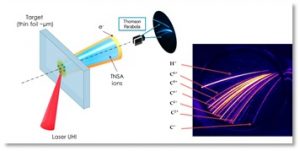Charged particle acceleration through laser-matter interaction is a well known phenomenon since long-time. It nowadays gains again the attention of a range of not exclusively scientific communities thanks to the advances in high energy lasers technology. In particular, the CPA technique allows T3 (Table Top Térawatt) lasers reaching, and sometimes getting over, intensities around 1020 W/cm2. Particle beams produced in this so-called “relativistic” regime (as accelerated electrons velocity is close to c) show outstanding features in terms of energy, brightness and short burst duration. As a consequence they are interesting for a large spread of applications (electric fields and density probing in plasmas, isochoric heating, positron, neutrons and medical isotopes production, health domain applications). Undoubtedly, the research in this field is stimulated to a large extent by the hope of using laser produced high energy particles for medical purposes. In particular, laser driven sources appear as a quite promising alternative to classical accelerator sources for proton beam therapy.
In Saclay, the PHI group has been working on this theme since 2005, using our ultra-high contrast 100 TW, 25 fs laser system (UHI100). In these conditions of interaction, we were the first to show, in the past, that both the side of the target exposed to the laser and the opposite side produce beams of particles with similar characteristics, which propagate, in directions opposite, normally to the target[1]. Today, our research focuses mainly on the study of the influence of appropriately structured targets (foams, nanostructures, grating-like patterns) on the emitting characteristics of proton beams[2].

|
Figure: Typical interaction scheme for TNSA mechanism (on the left) : when a high intensity laser beam is focused on a thin (~µm) target, a laminar bunch of protons (and other heavier ions) is accelerated from the target rear side. A Thomson parabola diagnostic is commonly used to record and characterize the ion emission ((on the right) . |
References :
[1] Proton Acceleration with High-Intensity Ultrahigh-Contrast Laser Pulses
T. Ceccotti, A. Lévy, H. Popescu, F. Réau, P. D’Oliveira, P. Monot, J. P. Geindre, E. Lefebvre, and Ph. Martin
PHYSICAL REVIEW LETTERS, 99, 185002 (2007)
[2]Energetic ions at moderate laser intensities using foam-based multi-layered targets
Passoni, M.; Zani, A.; Sgattoni, A.; et al. PLASMA PHYSICS AND CONTROLLED FUSION, 56, (2014)
Ceccotti, T.; Floquet, V.; Sgattoni, A.; et al. PHYSICAL REVIEW LETTERS, 111, 185001 (2013);
Micro-sphere layered targets efficiency in laser driven proton acceleration
Floquet, V.; Klimo, O.; Psikal, J.; et al, JOURNAL OF APPLIED PHYSICS, 114, 083305 (2013)


